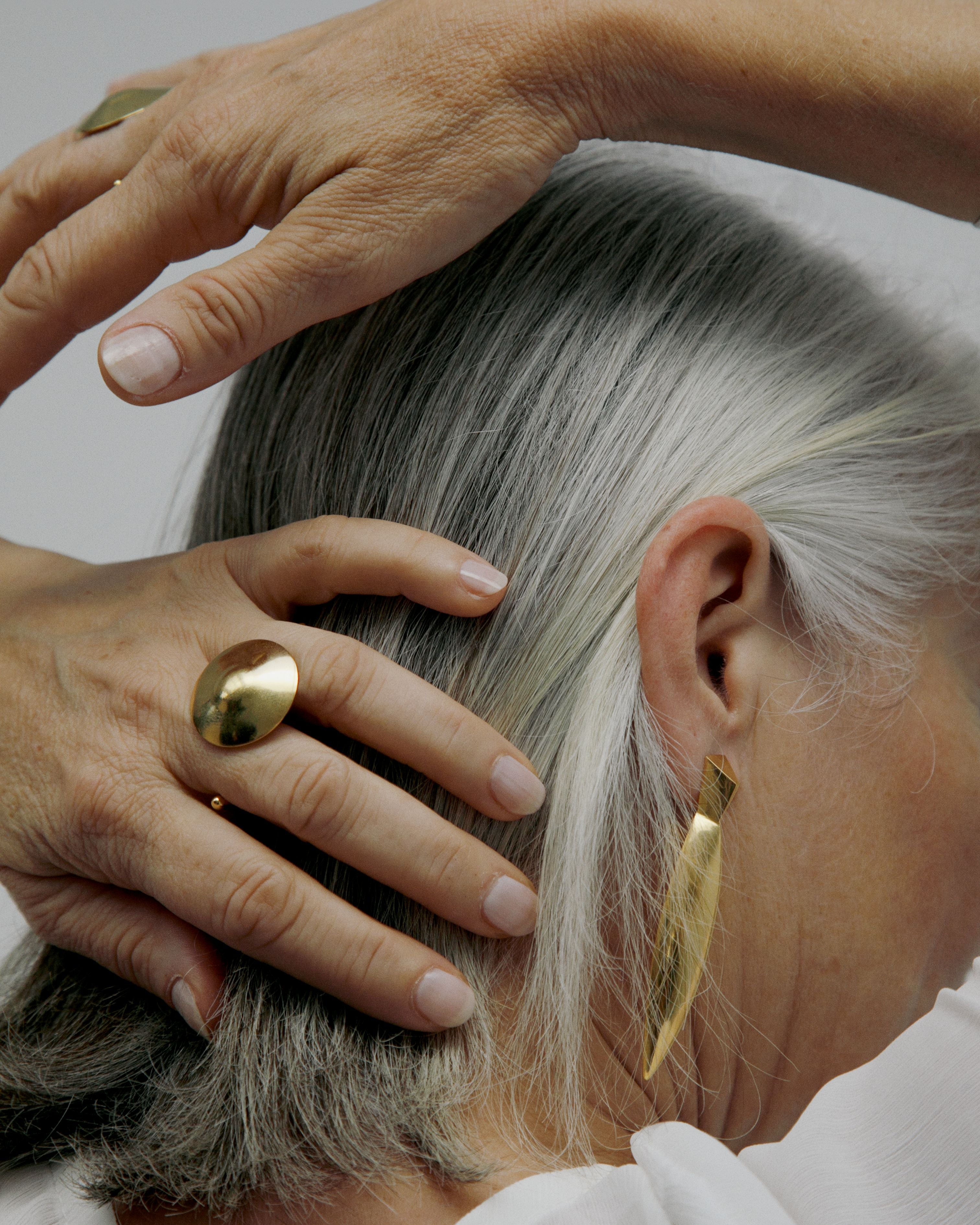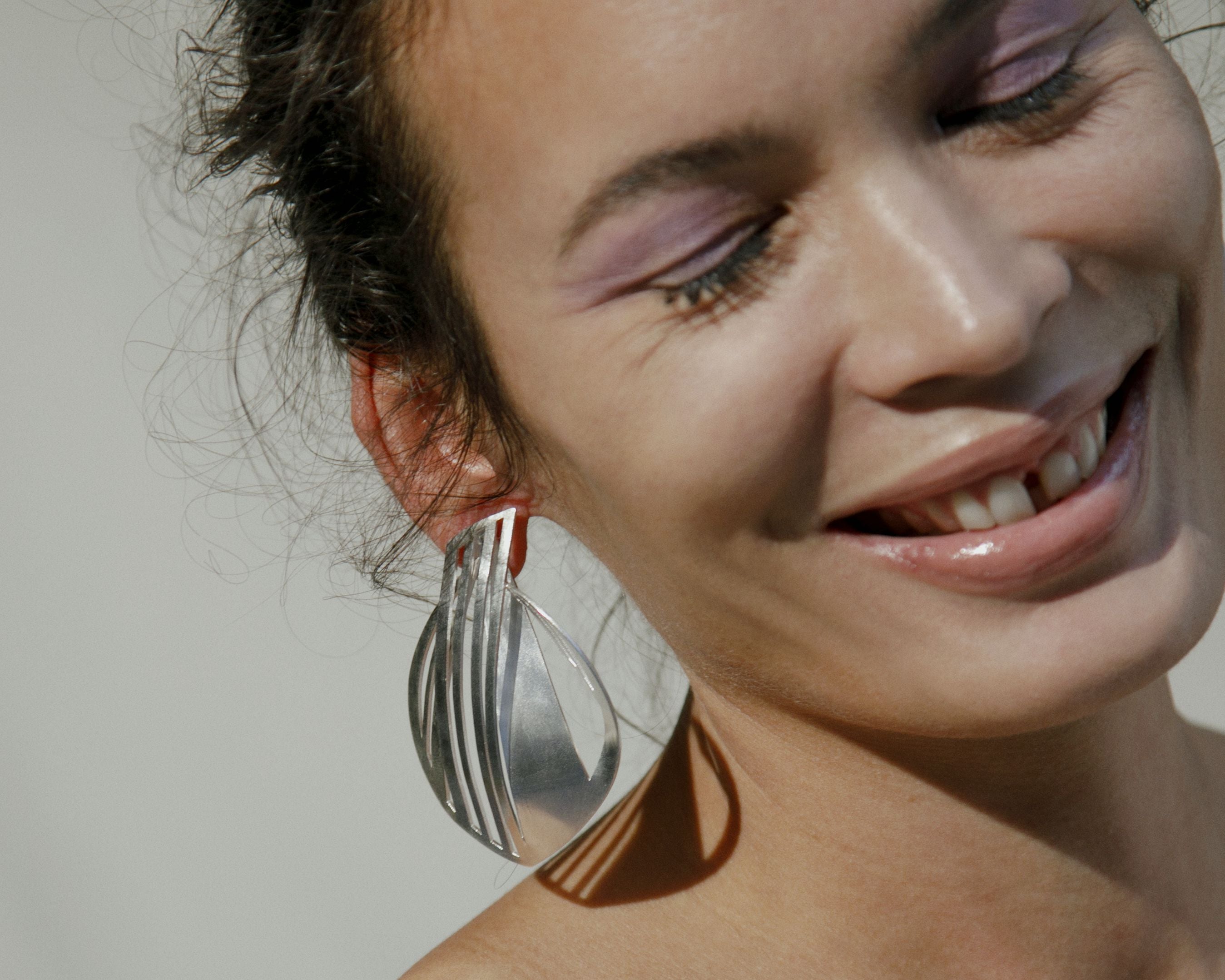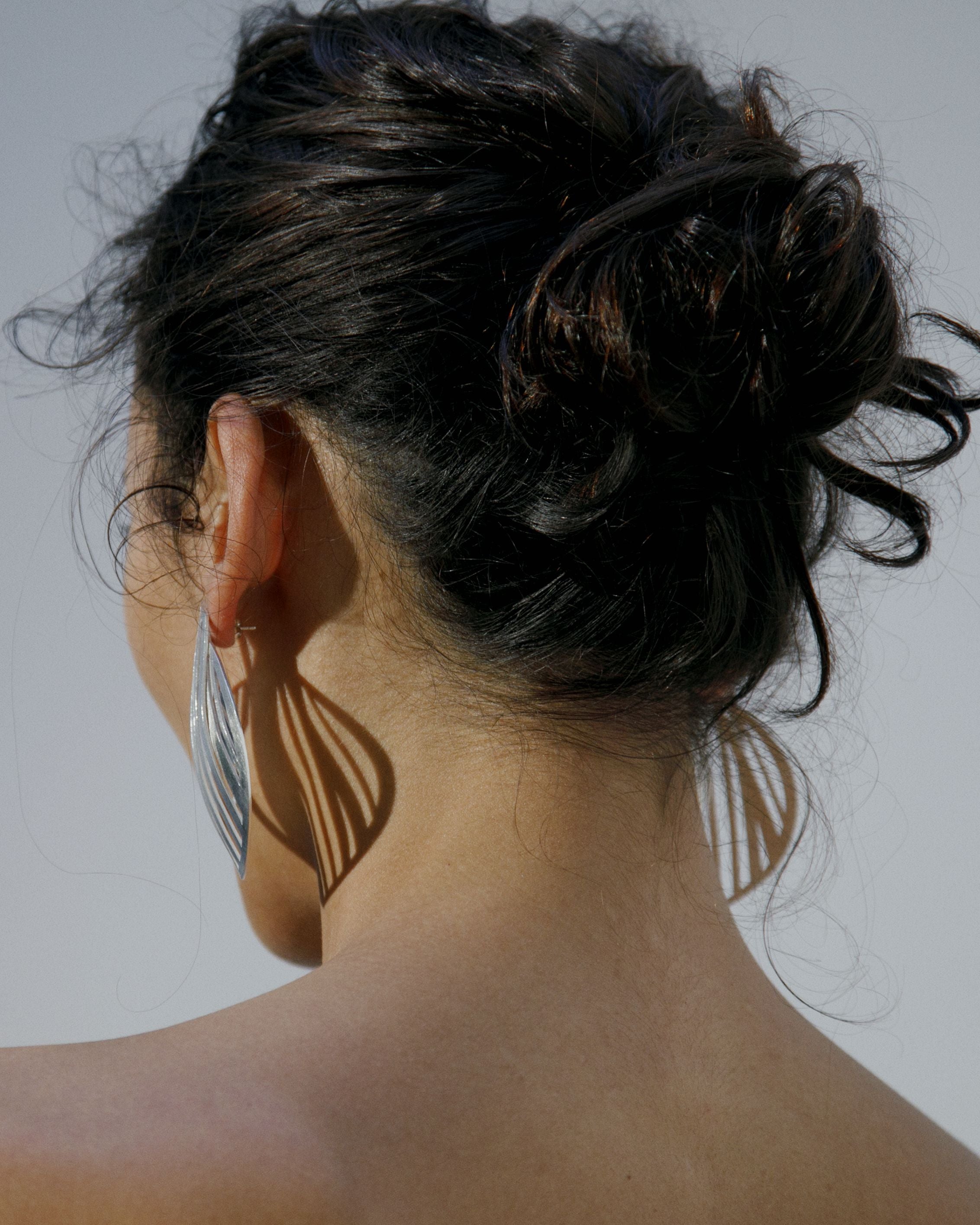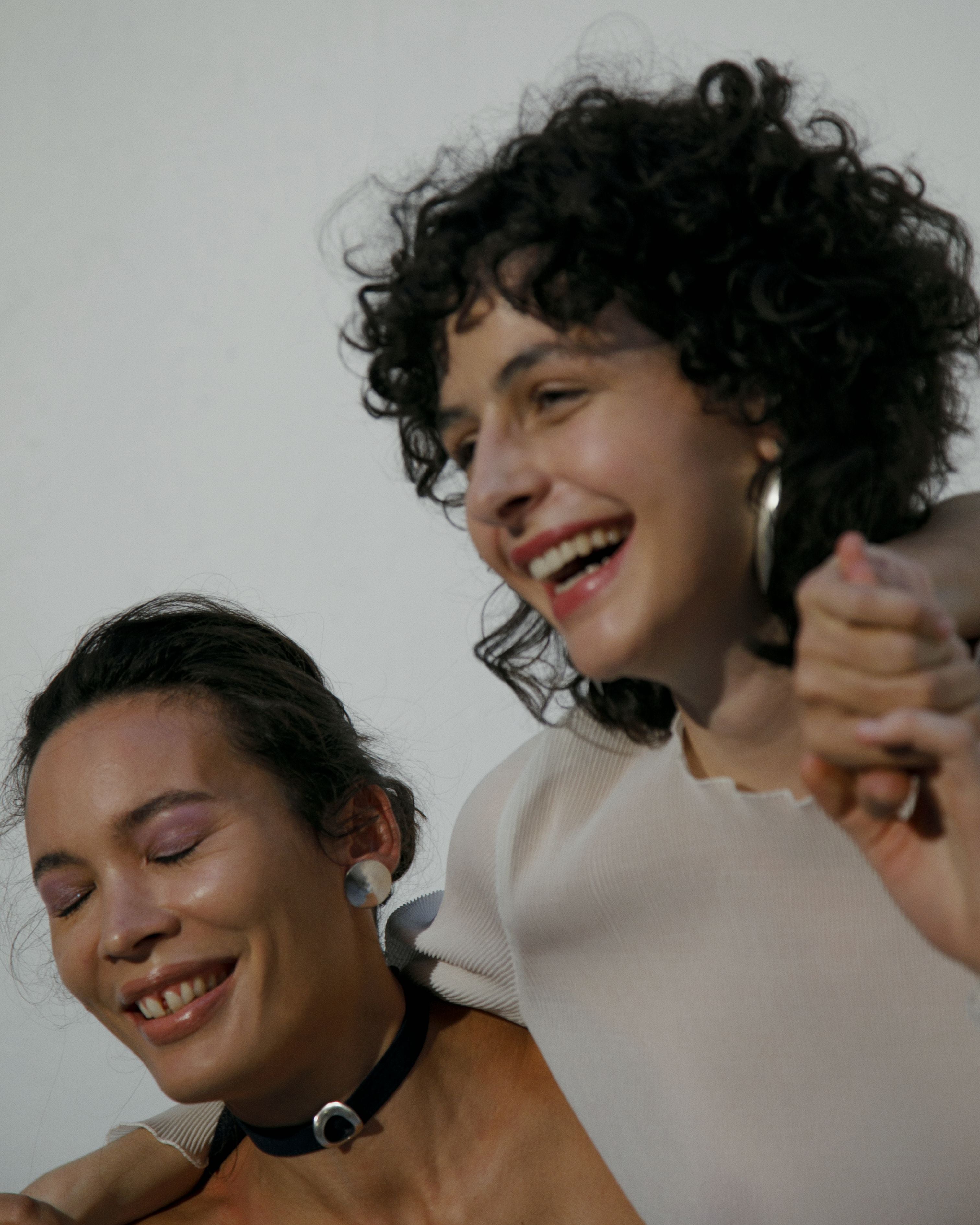MAUD ZUMERLE

Maud Zumerle’s atelier in the 19th arrondissement of Paris feels like a hidden gem. Tucked away near the Buttes Chaumont Park, the space is filled with light and creativity, much like Maud herself.
At her core, Maud is a ceramicist, and her jewelry is a natural extension of her passion for working with her hands. She takes pride in manual craftsmanship, designing, sculpting, and creating every piece by hand in her Paris atelier. Each of her sculptural, wearable pieces is more than an accessory—they are works of art. Drawing from her upbringing in the South of France, Maud blends personal memories with a refined, contemporary aesthetic.
In this interview, Maud shares her journey from the corporate world to becoming an independent designer at age 30. She reflects on how jewelry making gave her a renewed sense of confidence and purpose, and opens up about the challenges of creating her own path in a world that often undervalues craftsmanship. Maud’s story is a testament to the idea that it’s never too late to pursue your passions—and that there are still those who value meaningful, handcrafted work.




Tell me about your journey and how you became a jewelry designer.
Maud: My journey into jewelry design started a bit later in life. Before becoming a full-time designer, I spent 10 years working in marketing and communication. By the time I reached 30, I was ready for something new. I wanted to move away from the corporate world and do something more manual. I’d always loved working with my hands, especially ceramics, which I’d been doing since I was a little girl. That desire for hands-on creativity really pushed me toward a change.
At the time, becoming a full-time ceramicist didn’t feel like a realistic option. I didn’t feel legitimate enough to dive into it completely. So, I decided to try my hand at metalwork and began exploring jewelry design.
How did you go from considering jewelry design to fully committing?
Maud: I was still unsure about the direction I was heading in, but a friend of mine who worked for Premiere Classe—one of the big trade shows—gave me a pass to check it out since she knew I was thinking about jewelry design. While I was there, I came across this stand by a Brazilian designer named Regina Dabdab. Her work was stunning—sculptural pieces made from floating wood and semi-precious stones. Seeing her creations really stirred something inside me. I thought, “Wow, I want to create jewelry that makes people feel good, that evokes positive emotions.” That’s when I decided to reach out to her about doing an internship.
I contacted Regina, and we had an interview, but she didn’t need an intern at the time. She told me to take my time—make a clean break from my old job, and once I was ready, I could reach out to her again. So that’s what I did. After I left my job, I got in touch with her, and I ended up working with her for two years.
"During that first year, I was working full time with her. I learned how to drill stones and work with wood, but I felt like something was missing—I wanted to work with metal more."
How was your experience working with her for those two years? Did you immediately know you wanted to become a designer, or were you still uncertain?
Maud: I really wanted to make sure this was the right path for me. I wanted to understand what it meant to be an entrepreneur, to have my own brand, and to work independently. During that first year, I was working full time with her. I learned how to drill stones and work with wood, but I felt like something was missing—I wanted to work with metal more. I told Regina I wanted to go to school to really learn how to craft jewelry—how to make rings, earrings, everything. She encouraged me to go for it, and I continued working with her on weekends or a couple of days a week while I studied.
That’s when I decided to go all in. I found a school called l'AFEDAP which specialized in contemporary jewelry. The school was great because the students ranged from 18 to 60 years old, so it created a really interesting dynamic. I studied there for two years. I did my first year learning the basics of jewelry manufacturing, and in my second year, I specialized in contemporary jewelry. I was really happy to go back to school and learn something new—learning a craft felt so rewarding. But after that, I realized I wanted to keep going, to really perfect my style, craft, and ethos because I still didn’t fully know what my own jewelry identity was going to be.
So I applied for a design competition to get into HEAD in Geneva, which is a well-known design school. I was accepted into their jewelry program. It’s a three-year program, but because of my previous training, I was able to start directly in the second year.
Was there a significant difference between what you learned in Paris and your experience in Geneva?
Maud: It was intense. During the second year of my bachelor's degree at HEAD we didn’t do a lot of hands-on work in the ateliers. Instead, there was a strong focus on computers and 3D modeling, which was very different from what I’d done before. I felt a bit behind compared to the other students who had started in the first year and were more comfortable with that side of things. It was a challenge, but a good one.
My grades at school were good, but I knew it was time to take the leap and start my own brand. I didn’t want to stay in school forever. So, I came back to Paris, started looking for an atelier, and found people who wanted to share one with me. That’s when I really began to establish my brand.

Did you have any connection to jewelry before you started designing?
Maud: Not really, or at least not in the way you might think. But when I reflect on it, my connection to jewelry comes from my family. Jewelry has always played an important role in our lives. Growing up, I always saw my mother, grandmother, and aunts wearing jewelry. Whether it was Sunday family gatherings, weddings, anniversaries, or just day-to-day, my mother always paid attention to how she looked, and jewelry was a big part of that. She always wore a necklace, earrings, a bracelet, or rings. To her, jewelry was just as important as clothes or shoes.
I also have an aunt, who had a jewelry store. She didn’t hand make the pieces herself—she would assemble them, creating bold, statement pieces. She didn’t work with metal or sculpt wax, but she used to come to Paris to look for pearls and precious stones for her boutique.
"What I love most about it is how jewelry tells stories. For me, it’s almost like armor—when I don’t have my jewelry on, I feel bare. It’s hard to explain, but those small objects hold so much power."
It sounds like jewelry has always been a part of your family’s story.
Maud: Yes, in a way. It came to me later, but I’ve always loved wearing jewelry. What I love most about it is how jewelry tells stories. For me, it’s almost like armor—when I don’t have my jewelry on, I feel bare. It’s hard to explain, but those small objects hold so much power.

Is there something specific that inspires your pieces or collections? I noticed that you don’t really follow a traditional collection format, do you?
Maud: No, at first I wanted to create collections like many big brands do, but as an independent designer, I quickly realized that I couldn’t keep up with that rhythm. It was quite difficult, especially in terms of the investment required. Big commercial brands have the resources to produce collections regularly, but I’m not a big brand. I’m independent. I handle everything myself, from the initial idea to the final piece.
There are always designs that I’ve wanted to create for a long time, and I used to wonder if I needed to fit them into a formal collection. But then I thought, no, I’ll just make the pieces when I feel like it, one or two at a time. They don’t have to be part of a "collection" per se—they’re just pieces I’ve been thinking about and need to bring to life.
"I create when I’m ready and when I have the time each piece requires. I’ve freed myself from the pressure of constantly producing collections."
So you create pieces when the inspiration strikes and when they feel special to you?
Maud: Exactly. I create when I’m ready and when I have the time each piece requires. I’ve freed myself from the pressure of constantly producing collections. You know what I mean?
Absolutely. You don't succumb to the pressure of feeling like "I have to make this" on a schedule that doesn’t suit your style of workflow.
Maud: Yes, and now I just follow my creative instincts. It’s much more natural for me, and I feel more comfortable working this way.
When you have an idea for a piece, what inspires you the most or where do you draw your inspiration from?
Maud: In the beginning, my inspiration came from the jewelry I saw growing up—pieces worn by the women in my family. I tried to modernize those images and forms that had stuck in my memory, but always kept my own style with clean lines and a focus on metal. For example, the UFO line. People ask if I was inspired by UFOs, but I think it’s more because I grew up by the sea that many of my pieces resemble shells. My work tends to have a very organic feel to it.

Can you walk me through your process of designing jewelry?
Maud: Honestly, my process is very spontaneous.I work a lot with my hands. I do some drawing, but my main approach is more instinctive, starting with modeling shapes. I think about the pieces in advance—rings, necklaces, earrings, bracelets—and then start prototyping. I use a material called plasticine, which is like clay we use to create jewelry models. This helps me form the first templates for my designs. I then translate those into wax models to refine the shapes. Sometimes, I'll wear them to see how they feel and look.
"I always try to use high-quality materials. The tricky part is balancing the cost of materials with keeping the final pieces accessible to customers. I’d love to experiment more, but I always have to think about how it will affect the price."
Is there a specific material you like to work with? Do you plan on experimenting with other materials?
Maud: For now, I mostly work with metal because I love it—it's a noble material and it resonates with me. However, for my next "story"—I prefer to call it a story rather than a collection—I’m planning to introduce two new materials. I always try to use high-quality materials. The tricky part is balancing the cost of materials with keeping the final pieces accessible to customers. I’d love to experiment more, but I always have to think about how it will affect the price.

Can you explain the techniques you use when designing your pieces?
Maud: In jewelry, there are two main techniques. One is lost wax casting, and the other is working the metal directly from sheets. I like to work directly with metal, but sometimes I’ll use wire, cardboard, or paper to create models. For more complex shapes, like rings, I often sculpt elements in wax because some forms are hard to achieve directly in metal. Wax allows for more intricate details like hollows and pleats. It’s a method I use when necessary, but each piece requires a different approach.
Once I have a prototype, I determine the dimensions and think about how the piece will be produced, especially if it's going to be part of a mini-series. When you're making multiple pieces, the production process is different than if you're creating a single, unique item. I’ve learned how to optimize my designs so they can be produced efficiently without losing quality.
"The whole process is demanding—it requires a lot of planning from start to finish. That’s what I love about jewelry-making, though: it’s very challenging. You can’t rush it; you need to ensure every detail is perfect, from the finish to the final polish."
So it's not always the same method for each piece?
Maud: Exactly, it's never the same method. Each design requires me to think about the manufacturing process, the finishing touches, and how it will be polished. The whole process is demanding—it requires a lot of planning from start to finish. That’s what I love about jewelry-making, though: it’s very challenging. You can’t rush it; you need to ensure every detail is perfect, from the finish to the final polish.
Sometimes I revisit older prototypes. For example, I might improve a design I made four years ago because I’m a bit of a perfectionist. Even now, after six years of running my brand, I find ways to enhance my previous work.
"People have gotten used to fast fashion and instant gratification—they want things now. But jewelry, especially handmade, crafted pieces, takes time. There’s so much craftsmanship and expertise behind it, and that’s reflected in the price. It’s not just the cost of materials, but the entire process, the care, and the skill involved."
That’s what I love about artisans and this approach. You’re deeply committed to quality, even if it takes time.
Maud: Yes, absolutely. And that’s part of the challenge today. People have gotten used to fast fashion and instant gratification—they want things now. But jewelry, especially handmade, crafted pieces, takes time. There’s so much craftsmanship and expertise behind it, and that’s reflected in the price. It’s not just the cost of materials, but the entire process, the care, and the skill involved. In the end, I’m passionate about what I do. It’s hard work, but it’s also incredibly rewarding.
"My father, who was a craftsman and a sculptor, always said, "You can't be good at everything." He believed that it takes a lifetime to master one craft, so you should focus on that. That mentality has stuck with me."

Has the process of creating your jewelry taught you anything, such as patience?
Maud: Absolutely. It's taught me rigor, without a doubt, and also how to face my fears. The process can be daunting because it's really difficult. You make mistakes, pieces break, and you have to start all over again. It takes a lot of resilience. It’s also taught me patience, especially when I'm working on a new or custom piece. It can take months to complete something. My father, who was a craftsman and a sculptor, always said, "You can't be good at everything." He believed that it takes a lifetime to master one craft, so you should focus on that. That mentality has stuck with me. There’s already so much to learn in metalwork alone that I prefer to concentrate on perfecting that, rather than trying to do everything.
I totally agree. To create something of quality takes so much time.
Maud: Yes, especially with custom orders. It’s a creative process, so the idea doesn't always come immediately. You have to really think about the piece. But over time, I’ve become more confident. At first, I had impostor syndrome because I came into jewelry-making later in life.
In the end, though, you learn by doing. Today, I’m much more comfortable with my work. I don’t fear making mistakes as much anymore. I’ve also learned that what I create holds up well when compared to what’s out there, which gives me confidence.

Is sustainability something you consider when designing your jewelry?
Maud: It's kind of funny for those of us working in this industry because sustainability is something we've been practicing forever. In fact, we recycle everything. When clients bring in old jewelry, like something from their grandparents, we melt it down and reuse it. Or if we can't reuse it ourselves, we send it to the goldsmith who melts it down. Nothing is wasted. Even the dust from the goldsmithing process is collected, treated, and turned back into usable metal.
"That's what makes me laugh when I hear big brands promoting their "recycled gold" like it's something revolutionary. All of us, especially artisans, are already working with recycled metals. We work in small quantities, and most of what we buy, whether it's fine gold or silver, has already been through this recycling process."
So, are you saying that all of your jewelry is made from recycled and sustainable materials?
Maud: Yes, exactly. That's what makes me laugh when I hear big brands promoting their "recycled gold" like it's something revolutionary. All of us, especially artisans, are already working with recycled metals. We work in small quantities, and most of what we buy, whether it's fine gold or silver, has already been through this recycling process.
The real problem is fast fashion—those super cheap, mass-produced jewelry pieces. I don’t even know what materials they use or where they produce them. It’s certainly not sustainable. Everything I make is created in Paris. My suppliers are all local. So, yes, my jewelry is sustainable.
Is there a particular piece you've made that you're especially proud of or that holds a special meaning for you?
Maud: Yes, actually. It's a pair of earrings I made early on called the WT earrings. I made these earrings when I was still in school. They were my first pair, and I still make them today. I initially made them small, almost like a wearable sculpture, because the design is mirrored for both ears. They have this mix of being a bit old-fashioned, almost art deco—though I’m not really into the art deco style—but at the same time, they feel very futuristic with their sharp, dynamic lines. They’re sculptural and vivid, and I think they really represent who I am as a designer. I love them because they’re not something just anyone could make or imagine.
"First and foremost, I would say my brand is very personal. To really understand my jewelry, you need to know me. Each piece I make has a story behind it, and I believe when people learn the story, it adds meaning."
How would you describe your jewelry and your brand? What is the style or essence?
Maud: First and foremost, I would say my brand is very personal. To really understand my jewelry, you need to know me. Each piece I make has a story behind it, and I believe when people learn the story, it adds meaning. It's like when someone explains the process behind something – once you know the story, the piece resonates more. My clients often tell me they come back because they understand my way of working, and they feel connected to the universe I’ve created. My jewelry isn’t mass-produced; it’s handmade, crafted with care, and my clients appreciate that personal touch. They feel part of something special.
In more common terms, my pieces are artisan jewelry, created by hand. Some people tell me my designs are very distinctive and recognizable, but I still think I can push things further, to make my pieces even more unique. It’s a balance between being innovative and still creating pieces that people want to wear.
"As independent designers, we want to stay true to ourselves, but the reality is, you also need to sell your work to make a living. You’re constantly walking that fine line between creating something that feels authentic and something that’s commercially viable."
Do you think it’s hard for independent designers to strike that balance between being creative and making pieces that sell?
Maud: Yes, definitely. As independent designers, we want to stay true to ourselves, but the reality is, you also need to sell your work to make a living. You’re constantly walking that fine line between creating something that feels authentic and something that’s commercially viable. I had a hard time with that idea at first—thinking about things like offering entry-level pieces or smaller, more accessible items.
It’s not easy because, even with smaller pieces, production costs are high. You can’t sell handmade jewelry for cheap, but you still want to have a range that appeals to different tastes. Not everyone wants big, bold earrings, so you have to cater to those who prefer more subtle pieces, too. But it’s important to maintain that creative freedom.
Who do you envision wearing your pieces?
Maud: My clientele is really varied. It surprises me sometimes. I don’t design with a specific type of woman in mind, but it turns out the people who are drawn to my work are those who appreciate craftsmanship and artistry. They like that my pieces are rare, that you won’t see them everywhere. My clients are people who want something unique and aren’t necessarily chasing big brands or logos. Many of them work in creative industries—fashion, art galleries, or design—and they understand the importance of supporting artisans.
What do you envision for your brand in the long term? Where do you see it going in the future?
Maud: My dream is to bring together two of my passions—ceramics and jewelry. I want to create a dialogue between these two mediums, using ceramics to help tell the stories behind my pieces. For me, ceramics can create an entire universe, and through that, I can give people a clearer understanding of my creative process and inspiration.
Ultimately, I’d love to have a showroom where I can showcase this dialogue between ceramics and jewelry—a place that invites people into my world, where they can experience my work in a more immersive way. That’s the long-term dream.

"By choosing this path, I’ve slowed down, and I’m working with something tangible that feels meaningful. It’s a bit of a political act in that sense—going against consumerist madness and mass production. It’s hard being an independent artisan, doing everything yourself, but I couldn’t imagine living any other way now."
Is there anything else you’d like people to know about you or your work?
Maud: I think the most important thing is for people to understand that what I do goes beyond just making jewelry. I love working with metal, but my decision to become an artisan wasn’t just about the craft—it was also about choosing a different way of life. I left a corporate job where I was making good money, but it didn’t fulfill me. I felt disconnected from what mattered. It didn’t make sense to me.
By choosing this path, I’ve slowed down, and I’m working with something tangible that feels meaningful. It’s a bit of a political act in that sense—going against consumerist madness and mass production. It’s hard being an independent artisan, doing everything yourself, but I couldn’t imagine living any other way now.
For me, it’s incredibly rewarding when people take the time to understand and appreciate the process behind what I do. It’s proof that not everyone is caught up in the fast-paced, disposable way of living, and that gives me hope.
In the beginning, it was tough. I had meetings with buyers, and they didn’t understand what I was doing. They’d tell me I didn’t have enough products, that I needed to have more pieces to sell in large stores. But I’ve come to realize that it’s okay. I might not be in big department stores, but that’s fine. I’m doing things at my own pace, staying true to what I believe in, and that’s what matters.
This interview has been edited and condensed for clarity.
